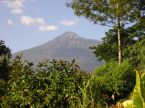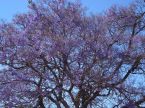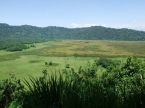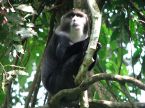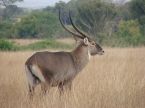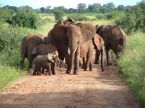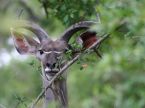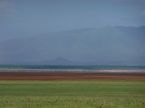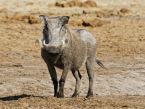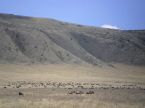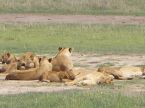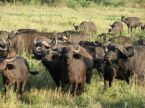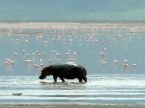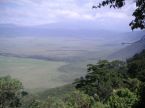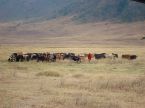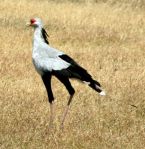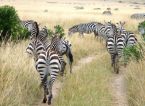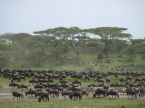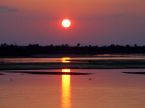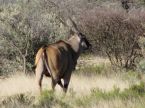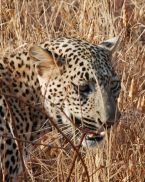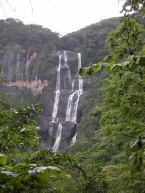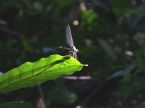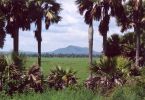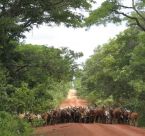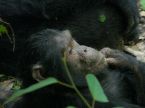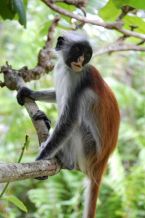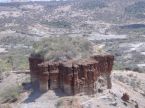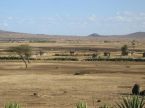



National parks and game reserves
Arusha National Park
The Arusha National Park is a marvel, unfortunately often ignored by visitors although it has many different facets.
It is the only place in Northern Tanzania, where the black and white colobus can be easily observed. In the middle of the forest is the Ngurdoto Crater containing many wetlands frequented by buffalos and warthogs.
Further north, you can admire the beauty of the Momela lakes, which have each a different colour of blue and green. They support a rich variety of water birds and defassa cobs who love their wet shores.
Giraffes, zebras and antelopes are frequently observed in the park. It is also possible to see hyenas and leopards, but the lions and elephants are not common in the Arusha National Park.
Early in the morning, the view on Mount Meru and Kilimanjaro is the most beautiful.
Situation : the park surface is 137 kmē. It is located thirty kilometers from the city of Arusha.
How to get there : forty minutes of good road from Arusha. Approximately 60 kilometers (35 miles) from Kilimanjaro International Airport. The Momela Lakes and Ngurdoto crater can be visited in half a day at the beginning or at the end of a safari.
Activities : 4wd safaris, walks in the forest with a park ranger, ascent of Mount Meru (good preparation for the Kilimanjaro)
Tarangire National Park
Tarangire is a very dry park, but despite the oppressive sun, dust and dryness, it is full of life.
Large herds of elephants digging the dry river bed to find water, while wildebeests, buffalos, zebras and antelopes congregate around lakes becoming smaller. This is one of the few places in Tanzania where you can observe desert antelopes such as the oryx and the amazing gerenuk (or "long neck" gazelle).
Elephants live permanently in the park, but Tarangire will also delight the most avid birdwatchers, who may contemplate some 500 species.
Many termite mounds rise throughout the park, where the graceful mongooses, red and yellow barbets and pythons find their homes. Lions and leopards are also found in Tarangire, the firsts sleeping in the shade of baobab trees and the seconds resting on the branches of sausages trees.
Situation : the park surface is 260 kmē. It is located 120 km from the city of Arusha.
How to get there : good asphalt road from Arusha and Manyara. To / from the Kuro airport: smallt aircraft flights from / to Arusha and Serengeti.
Activities : 4wd safaris, walking safaris with guide, visit of Maasai and Barbaig villages .
Lake Manyara National Park
Located at the foot of the Rift Valley escarpment, the Lake Manyara National Park is of great beauty.
The crossing of the park begins on a track through the forest where primates, antelopes and various species of birds live. This jungle is then replaced by a large plain where large herds of buffalos, wildebeests and zebras are grazing . The famous lions of Manyara climbing in the trees also live in this part of the park.
The lake, which represents two thirds of the park, is home to a bird fauna of high quality. Many species of birds live near the lake, including thousands of flamingos which give a pinkish colour to its waters.
Situation: the park surface is 315 km ē, 190 of which are represented by the lake. The park entrance is located at the exit of the lively village of Mto Wa Mbu, after 130 km on good asphalt road from Arusha. The Ngorongoro crater and Karatu are located one hour from Manyara.
How to get there : by road or small plane from/to Arusha and Serengeti. A flight connection to the Selous Game Reserve is also available.
Activities : 4wd safaris, canoeing (depending on the level of the lake), mountain biking, shopping at the Mto Wa Mbu craft market.
Ngorongoro Conservation Area
The Ngorongoro Conservation Area is a protected Unesco World Heritage site . It is situated between the Serengeti and the Manyara national parks, and near by the Eyasi and Natron lakes. Numerous ecosystems are represented in this protected area: plateaux, mountains, lakes, volcanoes, savanna and the famous Ngorongoro Crater.
This crater is a huge caldera of 20 km that was formed after the collapse of a volcanic cone. Its depth is 610 meters. It is the largest, non-flooded caldera on earth. The crater is one of the few places where you can observe the famous "Big Five". It is home to the rare black rhino and the largest concentration of lions in Africa. Many flamingos, pelicans and hippos live on the shores of Magadi Lake.
The famous wildebeest migration crosses the Ngorongoro Conservation Area between December and March. Other migrators like zebras and impalas follow this migration and also predators, attracted by this high concentration of ungulates.
The most inhabitants in the Ngorongoro Conservation Area are Maasai shepherds who are allowed to live here in freedom.
Situation : the park surface is 8280 kmē, 320 for the crater. The altitude ranges from 960 to 3650 meters. Located 2:30h from Arusha and near to the small town of Karatu.
How to get there : by road or by small aircraft from Arusha. Note that the weather rarely permits to land on the runway of Ngorongoro. The close aerodrome of Manyara will generally be used.
Activities : 4wd safaris, walking safaris on the edge of the crater with a ranger of the conservation area, visit of manyattas (Maasai villages), trek to the Olmoti and Empakaai craters.
Serengeti National Park
Millions of wildebeest pass here every year during their famous migration, forming long lines on dozens of kilometers ... Following the rain to reach the green pastures, they cross the Mara River natural border to Kenya, risking their lives when diving in these waters infested by crocodiles. Large herds of zebras and gazelles follow them in their quest for new pastures.
At the end of the migration, between August and October, when the animals are living in the adjacent park of Masai Mara, the park still houses a few herds of resident wildebeests. There is also a large number of buffaloes, elephants, giraffes, impalas and topis. Some species of beautiful birds like ostriches, eagles, secretary birds and fish eagles are living in the park. But the Serengeti is particularly home of a large population of predators: lions, leopards, cheetahs, hyenas, jackals and servals.
The landscapes of Serengeti are characterized by its vast plains, large termite mounds, rivers, and its "kopjes" (large round rocks on which the lions like to rest).
Situation : the park surface is 14 750 kmē and it lies 350 km from the city of Arusha and next to the Masai Mara park at the border to Kenya.
How to get there : small aircraft flights from Arusha, Manyara and Mwanza. By road from Arusha (takes a day's drive), Manyara, Tarangire and Ngorongoro Crater.
Activities : 4wd safaris, fly in a hot air balloon in the early morning.
Best season for the migration : November to July. Best for watching predators is June to October.
Selous Game Reserve
Selous is the largest reserve in Africa and home of the largest elephants herds, who enjoy bathing in the waters of the Rufiji River. It houses a large concentration of animals, including the rare wild dogs.
A safari in the Selous Game Reserve is a unique experience in East Africa: the Rufiji River and its many elephants, hippos and crocodiles is similar to some landscapes of the Okavango Delta in Botswana. Less popular than the northern parks, it is much wilder and the animals shyer.
Situation : The reserve surface is 55 000 kmē. It is crossed by the Ruaha and Rifiji rivers and is 8 hours drive south-west from Dar Es Salaam.
How to get there : From Dar Es Salaam by road (including 8 hours drive) or by small aircraft (recommended especially between February and April when the road conditions can become very bad).
Activities : 4wd safaris, boat trip on the Rufiji River for a different approach of hippos and elephants.
Mikumi National Park
Crossed by the road linking Dar es Salaam to Iringa, the Mikumi National Park is located north of the vast Selous Game Reserve. This is the most easily accessible southern park from Dar Es Salaam. The Mikumi landscapes and the Mkata plain savanna are similar to those of the Serengeti in the north.
Mikumi is the tanzanian park where you will have the best chance to watch elks, the largest antelope in the world, as well as the rare black sable antelope and the elegant kudu. North of the park, two lakes are home to many hippos and the entire park hosts more than 400 bird species.
Situation : the park surface is 3 230 kmē. It is located 280 kilometers west of Dar Es Salaam and north of the Selous Game Reserve.
How to get there : Four hours' drive from Dar Es Salaam via Morogoro on good asphalt road. Charter flights from Dar, Arusha and Selous.
Activities : 4wd safaris and hiking.
Ruaha National Park
The Ruaha National Park is home to over 10 000 elephants, the largest population of all parks of East Africa. The Ruaha River which crosses the park brings life to these arid stretches, sometimes as a large river during the rainy season, and often limited to a few water holes during the dry season.
Ruaha is a superb wildlife conservation area. Thanks to an excellent network of trails, you will be able to discover this beautiful park and watch the large predators such as lions, cheetahs, leopards, striped and spotted hyenas and several groups of the rare endangered wild dogs.
A wide variety of antelopes populate the Ruaha National Park because of its location between forest and savanna, with the rare kudus, black sable and roan antelopes. Birds are also very well represented at Ruaha including endemic species of central Tanzania.
Situation : the park surface is 10 300 kmē. It is located in the centre of the country, 130 km from the town of Iringa.
How to get there : 10-hour drive from Dar Es Salaam via Mikumi and Iringa. Regular and charter flights from Dar es Salaam, Selous, Serengeti, Arusha, Iringa and Mbeya.
Activities : 4wd safaris and walking safaris, discovery of the remains of the Stone Age at Isimila, one of the most important historical sites in Africa.
Udzungwa Mountains National Park
The green forests of Udzungwa are magic: consisting of huge trees over 30 meters high covered with ferns, Udzungwa is a truly unique destination.
The Udzungwa forest area is the richest in East Africa and home to many species of animals and endemic plants. It is ideal for hiking and includes an excellent network of hiking trails. The walk to the Sanja waterfall, 170 meters high, is a very nice trip of half a day.
Udzungwa hosts over 400 species of birds some of which are specific to this wonderful garden of Eden. Similarly, from the six primate species recorded in the park, two of them exist only here. Udzungwa is undoubtedly a jewel that we advise you to discover when you visit the south parks.
Situation : the park surface is 1 990 kmē. It is located 350 km from Dar Es Salaam and 65 km from Mikumi.
How to get there : by road from Mikumi National Park, on the way to Ruaha.
Activities : Hiking.
Katavi National Park
Katava is a beautiful park that has kept all its authenticity because of its isolation and its location far from major tourist routes. Katava, third park of Tanzania for its size, houses the largest concentration of hippos and crocodiles in the country who have found refuge in the Katava and Chada lakes. It is also, like other parks in the south, one of the few places in Africa where you can observe elks, sable and roan antelopes.
During the dry season, the park unveils all its beauty: the lakes are then reduced to swamps and as it is the sole place where water can be found on hundreds of kilometers, they are visited by huge herds of elephants, impalas, zebras and giraffes, representing great opportunities of meals for large predators.
In the same period, the concentration of hippos in the swamps creates impressive scenes of violently fighting males.
Situation : the park surface is de 4 470 km2. It is located southwest of Tanzania.
How to get there : Charter flights from Dar Es-Salaam or Arusha.
Activities : Hiking, safaris in 4wd cars.
Mahale Mountains National Park
Accessible only by boat, this beautiful park is unique in Africa. Surrounded by the blue waters of Lake Tanganyika, it has beautiful white sand beaches and is covered with a deep jungle until over 2000 meters high.
The Mahale Mountains are home to a large population of the last African chimpanzees. Walking to the Mahale chimpanzees is an unforgettable experience that you will long remember. Other magnificent primates populate the park, as the red colobus, the crowned cercopitheque or the endemic colobus of Angola.
Situation : the park surface is 1 610 kmē. It is located at Lake Tanganyika in western Tanzania.
How to get there : Charter flights from Dar Es-Salaam, Arusha or Kigoma.
Activities : Watching of chimpanzees, hiking, fishing, swimming in the clear waters of the lake.
Other interesting sites
Lake Natron:
The Lake Natron is a saline lake whose size varies depending on rainfall. During the rainy season it reaches its maximum, even up to Kenya. Despite the arid climatic conditions, Lake Natron is full of life. Its waters loaded with spirulina attract flamingos who come here for breeding, as well as several thousand other species of birds. This wild region, dominated by the Ol Doinyo Lengai volcano, the sacred mountain of the Maasai, will delight all visitors.
Situation : The lake surface varies between 600 and 1000 kmē (according to the rainfalls), and its depth up to 3 meters. It is located at the extreme northern Tanzania, near Kenya.
How to get there : on the only track from Serengeti, Ngorongoro, Manyara and the Kenya border at Namanga. Some local airlines arrange flights around the Lengai volcano.
Activities : discovery of the lake shores by foot or in 4wd vehicles, visit of Masai villages, climb of the Lengai volcano, walking along the Ngare Sero river and bathing in its waterfall.
Olduvai gorge:
located in the Ngorongoro Conservation Area, on the road to the Serengeti National Park, Olduvai Gorge can be considered as the cradle of mankind. Two species of hominids lived in these places, Australopithecus boisei and Homo habilis. The first gradually disappeared replaced by Homo erectus, then came Homo sapiens, our closest descendant.
Olduvai has become an excavation site led by Louis and Mary Leakey who managed to collect the remains of Australopithecus boisei. Their research confirmed that man has his origin in Africa, especially as many human fossils were found on other places in East Africa.
